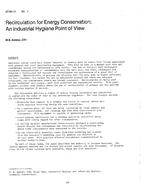Description
Increased energy costs have forced industry to develop ways to reduce heat losses associated with general and local ventilating equipment. This must be done in a manner such that air contaminant levels are maintained at safe levels. The use of indirect heat exchangers minimizes reintroduction of contaminants into the work area, but these exchangers are relatively inefficient and require the installation and maintenance of a great deal of equipment. Reintroduction of process air directly into the work area is highly efficient for heat recovery, but unless the air is adequately treated and there are adequate safeguards, air contaminant levels may become excessive. Recirculation is being used in the industrial environment, with both predicted and unpredicted results. This paper presents several case studies where the use of recirculation of exhaust air was applied with varying degrees of success.
The discussion involves a number of widely varying situations and industries. It emphasizes the point of view of the industrial hygienist. The case studies include the following situations:
- Effective dust control in a foundry did little to control carbon monoxide exposure occurring during the same operations.
- In a machine shop, oil mist was being controlled by local exhaust and general ventilation. Air cleaning was done with electrostatic precipitators. This equipment is capable of generating ozone.
- Local exhaust ventilation for a welding operation controlled metal fumes with little regard for other contaminants.
- A ceiling material manufacturer intentionally designed a ventilating system whereby one contaminant was controlled by recirculating air while other contaminants were exhausted to the outside.
- In the electronics industry, smoke from hand soldering was removed from the operator’s breathing zone for general air dilution in another area. This practice affected contaminant concentrations in another worker’s area.
In each of these cases, the paper describes the industry or process involved control measure applied and the desired and actual results are also discussed. If alternatives to the chosen solution were available, these are also described.
Citation: Symposium Papers, Atlanta, GA, 1984
Product Details
- Published:
- 1984
- Number of Pages:
- 8
- File Size:
- 1 file , 750 KB
- Product Code(s):
- D-AT-84-14-1




